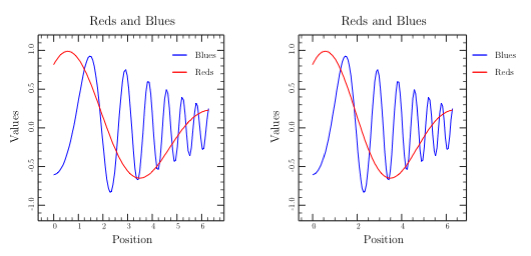Figures and Plots
FigureMaker methods
context(cmd, cmd_args=()) [ doc ]
Save the state before and restore after executing `cmd(t)` INPUT cmd -- a function or method which makes a plot The context routine saves 'state', executes the given block, and then restores state. The state being saved and restored consists of the attributes defining the page setup (frame, bounds, axes), graphics (clip region, stroke and fill colors, line width and type, etc.), axis label settings, and legend layout settings. Some of the things it saves and restores are arrays (such as the optional arrays of locations for major tick marks on the axes). In these cases, context will save and restore the pointer to the array, but it doesn't do anything about the contents of the array. Similarly, for text strings such as the title, it will save and restore the pointer but not the contents. Among the things that it does *not* save/restore is the saved legend information (as opposed to the legend layout attributes which are saved). This makes it possible to gather legend information from a subplot while still isolating it in its own context. Routines such as `show_plot()`, `subplot()`, and `subfigure()` make use of context to prevent side-effects from the execution of the code body 'leaking' out to pollute the caller's environment. The practical result is that in writing plotting routines, you can safely change various settings without needing to restore the old values when you finish. This becomes critical when you begin to combine several plots into a composite plot.
doing_subfigure() [ doc ]
Sets the `self.root_figure` flag to False. Is called on entry to the `subfigure()` routine. Provided as a convience for your plotting routines.
doing_subplot() [ doc ]
Sets the `self.in_subplot` flag to True. Is called on entry to the `subplot()` routine. Provided as a convience for your plotting routines.
rescale(factor) [ doc ]
Calls both `rescale_text()` and `rescale_lines()` with the given `factor`.
show_edges() [ doc ]
Makes a series of calls to show the frame edges (`show_top_edge()`, `show_left_edge()`, etc.)
show_plot(cmd, left=0.0, right=0.0, top=0.0, bottom=0.0) [ doc ]
Show a plot INPUTS cmd -- a function or method which makes a plot left -- left bound right -- right bound top -- top bound bottom -- bottom bound The first action of `show_plot()` is to call `set_bounds()` to set up the figure coordinates for the plot. Then, inside a call to `context()` so that the current state will be restored later, it calls `clip_to_frame()` followed by the block defining the plot. Finally, it calls `show_plot_box()` to take care of the axes and labels.
show_plot_box() [ doc ]
Makes a series of calls to show the axes, edges, title, and axis labels. This routine is called by `show_plot()` after the contents of the frame have been finished.
show_plot_with_legend(cmd, legend_left=None, legend_right=None, legend_top=None, legend_bottom=None, legend_scale=None, plot_left=None, plot_right=None, plot_top=None, plot_bottom=None, plot_scale=None) [ doc | example ]
Show plot with legend
INPUTS
cmd -- command block
legend_left
-- left margin for legend
legend_right
-- right margin for legend
legend_top
-- top margin for legend
legend_bottom
-- bottom margin for legend
legend_scale
-- scale for legend
plot_left
-- left margin for plot
plot_right
-- right margin for plot
plot_top
-- top margin for plot
plot_bottom
-- bottom margin for plot
plot_scale
-- scale for plot
Adjusts margins according to the input argument, executes the
plot definition, then calls `show_legend()`. The arguments
except `cmd` are all optional, and default values are taken
from the `self.legend_defaults` dict. The margin sizes are
given as fractions of the current frame. The `plot_scale`
applies to the entire plot including the legend. The
`legend_scale` only applies to the legend.
Example
def legend_inside(t):
read_data(t)
t.show_plot_with_legend(reds_blues,
legend_left=0.65,
plot_scale=1,
legend_scale=1.3,
plot_right=0)
def legend_outside(t):
read_data(t)
def cmd(t):
reds_blues(t)
t.show_marker([0, 2, 4, 6], [0.2, -0.1, 0.3, -0.5],
marker=Circle,
scale=0.5,
fill_color=Teal,
legend='Spots')
t.show_plot_with_legend(cmd, legend_scale=1.3)
def legends(t):
read_data(t)
def cmd(t):
t.rescale(0.5)
t.subplot(legend_inside, right=0.6)
t.subplot(legend_outside, left=0.56)
t.subfigure(cmd, top=0.6)

subfigure(cmd, left=0.0, right=0.0, top=0.0, bottom=0.0) [ doc ]
Define a subfigure INPUTS cmd -- command block left -- left margin right -- right margin top -- top margin bottom -- bottom margin Inside a call to `context()`, `subfigure()` first calls `doing_subfigure()`, then calls `set_subframe()` with the margins, and finally executes the `cmd(t)` for the figure.
subplot(cmd, left=0.0, right=0.0, top=0.0, bottom=0.0) [ doc ]
Define a subplot INPUTS cmd -- command block left -- left margin right -- right margin top -- top margin bottom -- bottom margin Inside a call to `context(), `subplot()` first calls `doing_subplot()`, then calls `set_subframe()` with the margins, and finally executes the `cmd(t)` for the plot.
FigureMaker attributes
in_subplot [ doc ]
Flag starts False and is set to True by the `doing_subplot()` routine which is called on entry to the `subplot()` routine. This is simply provided as a convenience for routines that need to know whether they are being called as a subplot or as a top-level plot. Same as not `self.root_plot`.
root_figure [ doc ]
Flag starts True and is set to False by the `doing_subfigure()` routine which is called on entry to the `subfigure()` routine. This is simply provided as a convenience for routines that need to know whether they are being called as a subfigure or as a top-level figure. Same as not `self.in_subplot`.
in_subfigure [ doc ]
Flag starts False and is set to True by the `doing_subfigure()` routine which is called on entry to the `subfigure()` routine. This is simply provided as a convenience for routines that need to know whether they are being called as a subfigure or as a top-level figure. Same as not `self.root_figure()`.
root_plot [ doc ]
Flag starts True and is set to False by the `doing_subplot()` routine which is called on entry to the `subplot()` routine. This is simply provided as a convenience for routines that need to know whether they are being called as a subplot or as a top-level plot. Same as not 'self.in_subplot`.
PyTioga version: alpha (20071021)
Copyright (C) 2007 Taro Sato & Bill Paxton. All rights reserved.